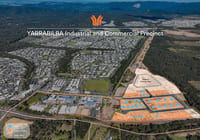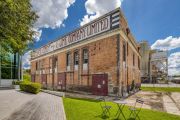
Behind Sydney's award-winning urban renewal of the Green Square project
Twenty years ago, just after the opening of Green Square station, four kilometres from Sydney’s CBD, a relatively young Australian landscape firm, McGregor Coxall, won an international competition to master-plan the town centre of what continues to unfold as Australia’s biggest urban renewal project.
Built over the cleared 278 hectares of heavily industrialised land, this massive residential, cultural, work, retail and play suburb is still a dusty, noisy scene of cranes and trucks, jackhammers and Stop/Slow signs.
Terrific bits of community infrastructure are already operational; not only are they well patronised, they’ve won major architectural awards.
These structures include the mostly-underground library (Architecture Review’s World’s Best Library 2019), the Joynton Street Creative hub, (2018 NSW AIA gold medal) and – too early for any gongs but probably a contender – the huge and imaginative Gunyama Park Aquatic Centre by Andrew Burgess Architects and others. The latter is modelled on Sydney’s beloved harbour and ocean pools and opened this month.
The roll-call of buildings by some of Australia’s most exciting architectural firms includes some settled residential blocks, such as the hollowed-ski-jump-shaped “Infinity” building by Koichi Takada that won the HIA’s NSW apartment award for 2020.
And although Green Square still presents as a jigsaw of unconnected structures and spaces, people are moving about as if they own it.
As one young commuter emerging from the station commented: “If it really does turn out to be what they’re promising, it’ll be fantastic.”
Sited on swampland at the interconnection of a bunch of suburbs – including Zetland, Alexandria, Waterloo, Rosebury and Beaconsfield – this grand City of Sydney vision of green star-rated urban repurposing has, as Professor Gerard Reinmuth of UTS’ School of Architecture observes, “been long in the planning but is now coming up quickly”.
While Professor Reinmuth, along with other urban planning critics, has reservations about the quality of a few delivered apartment complexes, he says, nevertheless, “it’s an interesting experiment on a huge scale”.
He believes it won’t be until 2040 that Green Square will be functionally cohesive but what it is offering is important “as one of the very few serious options that allows people to live in the city”.
“The alternative, of a city horrifically expanding ever westward into our food production land, is too awful to consider,” he says.
Another attribute he cites is that it is being designed by so many younger architecture studios.
“The buzz word is that, apart from Peter Stutchbury (responsible for Joynton Avenue Centre), it represents generational change,” he says.
“It’s a new city being made by a whole lot of next-generation architects.”
The density of Green Square will, when fully occupied by 60.000 residents and workers, be comparable to some of the world’s most closely settled neighbourhoods. Critical to its functioning, Professor Reinmuth says, is “the central civic spine”.
Running across from Green Square station, the connections work via a large paved plaza, beneath which is the subterranean library. Then comes the to-be-completed 6400-square-metre parkland to be known as The Drying Green, and then, in one direction, the multi-functional GPARC, or aquatic centre and playing field, and in the other, the creative hub.
Hoardings are still up around The Drying Green, where washed sheep fleece was once spread to dry, yet it is the keystone of the people’s centre. Adrian McGregor, founder director of McGregor Coxall, anticipates the finished piece will be in use by 2023.
As benign as a central park sounds, it has involved much site remediation, extraordinary underground water infrastructure to deal with a natural stream that traverses the land, and the creation of a montage spaces for different uses.
If the library is described as “the loungeroom of Green Square”, the pending park could be the collective backyard. “We’re providing different places for strategic uses,” Mr McGregor says.
“There’ll be the great Aussie barbecue area; a tilted lawn where you can sit and view the street. There’ll be a flat grass area for cricket and frisbee throwing, and steps so people can sit out and have their coffees,” he says.
An illuminated artwork will be visible from the surrounding apartments.
The design is also utilising and improving the running of the maligned Shea’s Creek by extracting some of its flow and running it through new plant- and insect-rich water features for three cycles before returning it to the Alexandra Canal.
The Drying Green, Mr McGregor believes, “will cater for modern life as a high-performance open green space. It’s got everything there for everyone, and the water running through it will cool the park.”
As it was when fell-mongering works and, later, car manufacturers arrived in the sandy stretches of the Botany swamplands, the water will be a major attraction. “A big asset for Green Square,” Mr McGregor says.










